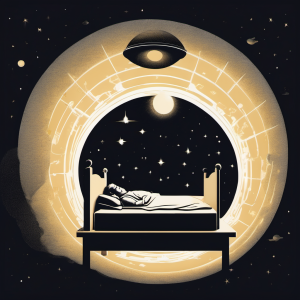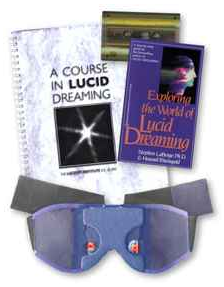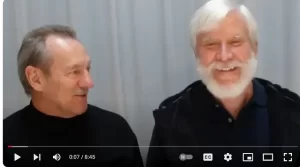 By KEN KORCZAK
By KEN KORCZAK
A Silicon Valley Tech Start-Up Claims to Have Enabled Two People to Share Information While They Were Both Asleep & Dreaming in Different Locations
An independent research firm described as a “Silicon Valley tech start-up” has recently claimed an intriguing breakthrough in the study of lucid dreaming.
An outfit called REMspace reported that, for the first time, two people achieved communication with each other while both were asleep and in the lucid dream state. They were located in separate homes.
I’ll have more to say about this, but a warning:
This story is going to take a bizarre turn. I’ll get to that in a bit — but first, a bit of background will be helpful.
WHAT IS LUCID DREAMING?
A lucid dream is a dream in which a person knows or is aware he or she is dreaming. For example, let’s say you are having one of those classic “flying dreams.” You experience yourself soaring through the air among the clouds or over a mountainous landscape.
Suddenly, in your dream, you realize: “Hey! I know that I can’t fly in real life. I must be dreaming!”
At that point, you may gain greater control or full conscious volition of action within the dream. In effect, it’s like being inside a virtual reality universe, except this VR world is not generated by a computer. Your brain is the “computer” orchestrating the fantastic scenario you are now immersed within. (Side note: I no longer consider this a viable model. Consciousness is not generated by the brain; it streams into the brain from an outside source. That’s a topic for another day, however).
Millions of people became aware of lucid dreaming in the 1980s when a Stanford University researcher proved — in a laboratory setting — that lucid dreaming was indeed a real phenomenon. That researcher was Dr. Stephen LaBerge, a by-the-book, scientifically rigorous psychophysiologist.
I won’t describe the innovative methodology Dr. LaBerge used to nail down the reality of the lucid dream state. However, he went on to publish two influential books that brought widespread public awareness about this natural human ability.
Those books were Lucid Dreaming and Exploring the World of Lucid Dreaming. In addition to educating the public about the lucid dream phenomenon, LaBerge’s books offered detailed instructions on how anyone could induce lucid dreams.

Furthermore, LaBerge’s team developed a cutting-edge “dream mask” called the NovaDreamer. This is a device one wears over one’s eyes at bedtime. The NovaDreamer uses sensors to detect what sleep researchers call REM, Rapid Eye Movement. It is known that when a person’s eyes appear to move rapidly from side to side beneath closed eyelids, that person is experiencing a dream.
The NovaDreamer detects rapid eye movement and flashes a red LED light onto the closed eyes of the dreamer. The goal is for the light effect to manifest inside the dream scenario in some way, alerting the subject to realize he or she is dreaming and thus can become lucid.
I EXPERIMENTED WITH THE NOVADREAMER
I purchased a NovaDreamer in the early1990s and experimented with it extensively. On several occasions, I was able to induce the lucid dream state. For example, one night I was in bed and noticed a flashing red light coming from outside my bedroom window. I thought I was awake, so I got up and looked out the window to discover the source of the red light.
I was stunned to see a large UFO in the starry sky above my house. The craft was sending a pulsing red beam down to my window. Riding on the red beam was a cadre of classic gray aliens headed right for me! GAK!
My first thought was: “Ahh! Aliens are coming to abduct me!”
But then I realized: “Wait a minute! This must be a dream! The flashing beam from the alien spacecraft is the NovaDreamer signaling to me from the outside!”
At that point, I became lucid within the dream and was able to “join in” on the narrative of what was happening. I engaged the “alien dream beings” in a series of intense and mind-blowing interactions. I’m not going to describe that now, however, because I want to get back to the story of REMspace.
RED FLAGS APLENTY
As interested as I was to read about the lucid dreaming breakthrough by REMspace, when I looked deeper into the story, red flags began to flutter. First, the story was reported by an online source called Chip Chick — in other words, not exactly the New York Times or Scientific American. Chip Chick bills itself as “a lifestyle brand with a female focus.”
Here are some of the headlines I find on Chip Chick:
His Wife Doesn’t Want Him to Accept a New Job Since He Will Need to Pay His Ex More Money in Child Support
She Spent $6,000 On Her Friend’s Wedding, But She Trash Talked Her Through the Whole Day
He Told His Dad’s Wife His Medical Condition is None of Her Business Since She’s Not His Mom.
Okay — whatever — I’m not saying anything is wrong with publishing “soft news.” Chip Chick is simply targeting a niche market to generate clicks. Good for them. To their credit, they occasionally mix in a science-related story. It’s just that I would not consider Chip Chick a “go-to” source for cutting-edge reporting on scientific topics, such as lucid dream experimentation.
DREAM MASKS GALORE
Next, I navigated over to the REMspace website, and lo and behold, I see this “Silicon Valley Tech Start-Up” is hawking its own version of a lucid dream induction mask with some of the same features the NovaDreamer brought out some 40 years ago.
I must add that REMspace is not the first to jump into the dream mask device market. Just a few others available are made by:
REMEE: Offers several dream masks at different price levels, starting at $39.00
SOMNI: Sells a dream mask for $115.00
CPAP.COM: It’s “Dreamlight Zen Meditation Smart Mask” sells for $199.00
DREAM RECOVERY STORE: O.G. Performance Sleep Mask for $60
The REMspace dream mask device, called “LucidMe,” is pending release and a price has not been announced.
NOW GET READY FOR THE WEIRDNESS
I next noted on the REMspace website that the founder and CEO of the firm is none other than Michael Raduga, a Russian man now living in the United States. In my 40 years of lucid dream study and practice, I have naturally consumed droves of books, articles and videos on the topic.
One guy that pops up frequently on YouTube is this guy, Michael Raduga. He is a passionate presenter of information on lucid dreaming, out-of-body experiences and other consciousness exploration techniques.
To put it kindly, I’ve always thought of him as a bit of an outlier. He’s exuberant and passionate about lucid dreaming, but I find his approach to be — how should I put it? — a bit wild and woolly.
HE DRILLED A HOLE IN HIS SKULL
Consider the fact that Michael Raduga recently purchased a “household drill” so that he could bore a hole into his own skull. He did so and then implanted “an electrode in his brain.”
That’s right!
He performed this delicate cranial drilling procedure in the comfort of his Siberian home!
In a July 2023 story published by Newsweek — which referenced a story in the Russian Telegram channel subsidiary, Mash Siberia — it was reported that Raduga endangered his life as a result of his do-it-yourself trepanation procedure. The hole he drilled in his head bled profusely, forcing him to flee to an emergency room in the city of Novosibirsk.
The Telegram article quoted Raduga who helpfully explained:
“I bought a drill, drilled a hole in my head and implanted an electrode in my brain.”
He said he did so to enhance his ability to successfully achieve the lucid dream state. And let’s give him some credit. Before he went to work on himself with a “household drill,” Raduga said he watched several “how-to YouTube videos” on neurosurgery.
Raduga added that his self-performed procedure:
“… opened up fantastic prospects for future dream control technologies.”
Raduga posted graphic photos of the whole event on X, the former Twitter. These images included photos with bandages wrapped around his head and also an X-ray that appears to show the electrode now lodged in his brain. (SEE PHOTOS HERE) What this electrode is actually doing inside his grey matter is not fully explained.
Whatever the case, and as far as I know, the dream mask that Raduga’s REMspace is developing for public release does not require users to drill a hole in their skulls nor for a chip to be “surgically” implanted in the brain.
I note that REMspace sells a variety of other lucid dream enhancement products, including dietary supplement capsules. These purport to deliver acetylcholine to the brain which supports lucid dreaming, REMspace says. Acetylcholine is a known neurotransmitter. It is an organic compound found in many common foods, including eggs, chicken breasts, beef liver and salmon.
Another REMspace offering is a free lucid dreaming app that teaches users lucid dreaming techniques, a way to dream journal and dream interpretation tips. The app will also work in sync with the REMspace dream mask when it becomes available, including the ability to share dream experiences with followers.
A ‘BREAKTHROUGH’ OR ‘OLD NEWS’
Now let’s get back to the recent accomplishment reported by REMspace — the ability of two dreaming test subjects to share communication while they slept in different locations.
Both subjects were being remotely monitored with electronic equipment. Details are sketchy. For example, I don’t know what type of equipment was used. Were the subjects sleeping with brainwave monitor contacts taped to their heads? Were they hooked up to an EEG? Was the experiment running through the aforementioned REMspace app? I haven’t been able to find out.
Whatever the case, the “communication” achieved between the subjects consisted of a single word, so it’s not like the two dreamers met up in a dream scenario location and had an in-depth conversation.
However, several other highly credible research groups have claimed far more significant communication between subjects as they both were in the lucid dream state and/or in the out-of-body state.

One of the most credible examples is reported by the physicist Tom Campbell, a long-time U.S. Army missile defense analyst and NASA contract scientist, Campbell was one of the first researchers to join consciousness exploration pioneer Robert Monroe as he was establishing his lab in Faber, Virginia. Campbell was a key player in creating what is now The Monroe Institute, a world-renowned entity in the study of altered states of consciousness.
Campbell often tells the story of how he and fellow researcher Dennis Mennerich, an electrical engineer, met up in the out-of-body state and engaged in lengthy and meaningful interactions with each other.
Campbell and Mennerich were not dreaming. They were in fully conscious out-of-body states. Both of them were situated in separate isolation chambers. They were wired up to monitor an array of feedback parameters on their brainwave activity and other physical data points, such as galvanic skin response (GSR). GSR is also called electrodermal activity (EDA) or skin conductance (SC). This is a measure of how electrical properties on the skin change in response to stress or emotional arousal.
Campbell and Mennerich were also fitted with microphones that enabled them to communicate with the controller of the experiment operating outside the two separate isolation chambers. After long practice, Campbell and Mennerich achieved the ability to communicate with “awake people in the outside world” while another part of their consciousness traveled in the “astral world” or out-of-body state.
But there are other credible examples of mutual dream scenario habitations as well, albeit less scientific.
One of them is the “shamanic dream practice” of New York Times bestselling author Robert Moss. A historian and journalist, Moss wrote for elite publications, including The Economist and New York Times Magazine. He also served as a speechwriter for British Prime Minister Margaret Thatcher. Moss is credited with coining her famous nickname, “The Iron Lady.”
After penning several NYT bestselling spy/thriller novels, Moss changed course in his career to dedicate his life to the study of lucid dreaming. He explains why in his book, The Boy Who Died and Came Back. (SEE MY REVIEW)
In his many books on lucid dreaming, Moss often discusses efforts among groups of avid lucid dreamers. They routinely “meet up” within pre-agreed-upon locations in the “dream realm.” They not only communicate with each other, but they also embark on fantastical adventures together, sometimes to far off planets in other galaxies and similar exotic locations.
Granted, Moss is not conducting rigorous scientific studies with equipment that gathers data, monitors brain waves and the like. However, I have spoken with several people I know well who have participated in his lucid dreaming seminars. They report spectacular experiences, including meeting up with and communicating with other people in the lucid dream state.
There are other examples as well, but I’ll stop here. My point is that the story of the REMspace “groundbreaking lucid dreaming breakthrough” is not terribly groundbreaking and not even something new. It’s also a story with a lot of weird tangents — the kind that surface-level clickbait stories tend to leave out.
NOTE: For more stories about lucid dreaming, please see: KEN-ON-MEDIUM.
With thanks to Ally
